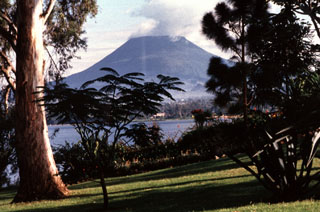Report on Nyiragongo (DR Congo) — 21 July-27 July 2021
Smithsonian Institution / US Geological Survey
Weekly Volcanic Activity Report, 21 July-27 July 2021
Managing Editor: Sally Sennert.
Please cite this report as:
Global Volcanism Program, 2021. Report on Nyiragongo (DR Congo) (Sennert, S, ed.). Weekly Volcanic Activity Report, 21 July-27 July 2021. Smithsonian Institution and US Geological Survey.
Nyiragongo
DR Congo
1.52°S, 29.25°E; summit elev. 3470 m
All times are local (unless otherwise noted)
According to a news article a collapse in Nyiragongo’s main crater on 24 July caused white-colored ash to fall in Goma. The ashfall caused no notable damage, though there were health concerns related to water quality. The director of Volcanological Observatory of Goma (OVG) noted that the collapse was not due to eruptive activity.
Geological Summary. The Nyiragongo stratovolcano contained a lava lake in its deep summit crater that was active for half a century before draining catastrophically through its outer flanks in 1977. The steep slopes contrast to the low profile of its neighboring shield volcano, Nyamuragira. Benches in the steep-walled, 1.2-km-wide summit crater mark levels of former lava lakes, which have been observed since the late-19th century. Two older stratovolcanoes, Baruta and Shaheru, are partially overlapped by Nyiragongo on the north and south. About 100 cones are located primarily along radial fissures south of Shaheru, east of the summit, and along a NE-SW zone extending as far as Lake Kivu. Many cones are buried by voluminous lava flows that extend long distances down the flanks, which is characterized by the eruption of foiditic rocks. The extremely fluid 1977 lava flows caused many fatalities, as did lava flows that inundated portions of the major city of Goma in January 2002.
Source: Agence France-Presse (AFP)

